OLD CITY Philadelphia building officials have ordered the
developer renovating Old City's Shirt Corner buildings to demolish the early 19th-century
row after engineers discovered wide cracks in the walls, indicating that the
structures were on the verge of collapse.
The order, issued Jan. 24 by the Department of Licenses and
Inspections, means the city will lose an important group of buildings that once
served as warehouses and offices for Philadelphia's port, and later became a
quirky retail gateway to Old City. L&I says the group of buildings at Third
and Market Streets is "imminently dangerous."
Leo Addimando, whose Alterra Property Group was renovating
and reconstructing the buildings to accommodate 59 apartments and a CVS store,
said he was disappointed but would abide by the decision. He expects to
finalize a safety plan with L&I inspectors Tuesday and begin demolition
Wednesday.
"I went into this with the intention of saving these
buildings," said Addimando, who serves as vice chairman of the
Preservation Alliance, an advocacy group. "But I've been convinced that I
have no choice."
The cracks and other structural problems were discovered in
mid-January while workers were peeling away drywall to prepare for the
renovations. After Addimando's engineering firm, Cooke Brown, pointed out the
cracks and bulges in the front facades, the developer said, he called in two
engineering consultants to assess the situation, Keast & Hood and O'Donnell
& Naccarato.
A report issued by Keast & Hood concluded that the
buildings were unstable and advised that they be taken down.
Addimando said he planned to build on the original
foundations, creating a faithful replica of the 19th-century row. Because the
group of buildings was landmarked, the Historical Commission must approve the
choice of brick, mortar, and other details.
Had the commission been certain that the old facades were a
lost cause, it might have encouraged Addimando to design a more modern-looking
replacement.
The buildings, which line the north side of Market Street,
have been deteriorating for years, and a previous proposal for the site also
involved constructing a facsimile. Addimando was the first developer to attempt
to save the structures.
"We've known for 10 or 15 years that these buildings
had serious structural problems, but we were so glad that Leo was adventurous
enough to try to reconstruct them," said Jon Farnham, the commission's
executive director. In the end, he added, "I wasn't surprised at all"
that the buildings were too far gone.
Source: Philly.com

No comments:
Post a Comment